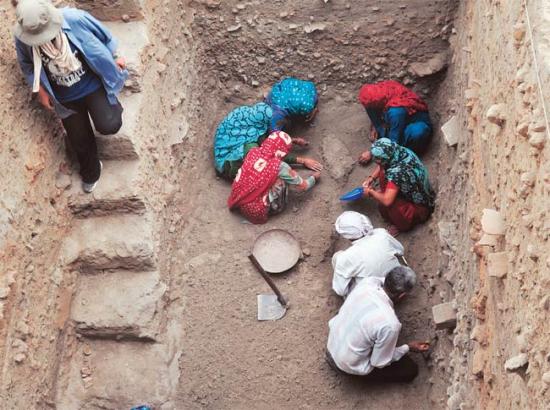Source - http://indiatoday.intoday.in/story/harappan-site-saraswati-river-indus-valley-civilisation/1/439505.html
 Archaeological Survey of India, in collaboration with Deccan College of Pune and scientists from Korea's Seoul National University, are excavating a site in Rakhigarhi of Haryana
Archaeological Survey of India, in collaboration with Deccan College of Pune and scientists from Korea's Seoul National University, are excavating a site in Rakhigarhi of Haryana
The Indus Valley civilisation, popularly known as Harappan civilisation, has been a puzzle for several decades now. But with the ongoing excavation in Rakhigarhi, Haryana, jointly conducted by archaeologists of Deccan College, Pune, and Haryana Department of Archaeology, along with forensic scientists from Seoul National University, South Korea, history is on the verge of being rewritten.
"After Rakhigarhi, we can say that the Harappan civilisation was at least 1,000 years older than earlier thought. And contrary to our longheld, conventional understanding, it first emerged in the east and then moved west, originating as it did in the heart of the Ghaggar-Hakra basin, regarded by many as the place where the Saraswati once flowed," says Vasant Shinde, vice-chancellor of Deccan College who heads the team of archeologists - the largest Harappan site overtaking Mohenjodaro in Pakistan's Sind province.
What's going to ruffle quite a few feathers, is Harappa's supposed Saraswati connection, especially the way the drying up of one probably led to the decline of the other.
Rewriting history
Shinde says that prior to his excavation it was believed that Rakhigarhi had all the three phases of the Harappan culture - 'Early', 'Mature' and 'Late'. "Our work proves that this place doesn't have the Late Harappan phase. It collapsed around 2000 BC," says he, adding: "I believe Rakhigarhi's sudden demise can be explained with the drying up of the Saraswati in 2000 BC."
Shinde's claim is supported by Amarendra Nath, former ASI's archaeology director who had carried out excavation in Rakhigarhi between 1997 and 2000. "The ASI has so far discovered over 2,000 Harappan sites spread over Punjab, Haryana, Uttar Pradesh, Rajasthan and Gujarat. Of these, about 1,400 can be located in the Saraswati belt alone, while the Indus belt doesn't have more than 300-400 sites," he informs, adding: "We, in the ASI, had reached this conclusion long back. It's just that this information is coming out now."
But not everyone is impressed. A Delhi University professor, wishing to remain anonymous, thinks this entire saga can only be analysed through the politicoideological prism, rather than the academic. "For me, Saraswati is a mythical river and nothing more. It's not a mere coincidence that all these things are coming up soon after the BJP came to power. It's an attempt to rewrite the history, the Aryan history," says he.

Shinde seems circumspect on the Aryan migration issue. "It's for historians to decide. But as an archeologist, I can say with confidence that for at least 7,000 years, there has been no migration into this region. You go to the village today, and you will feel you are walking through the same, old Harappan civilisation thriving 5,000 years ago. The style of pottery is similar. So are the food habits," says he.
Nath is more direct. "There will always be a set of historians who will continue to deny the existence of the Saraswati - to meet their ideological and personal requirements. They can afford to do that as history can be interpretational. (But) Not archaeology, which is based on solid evidences and facts. And evidences for long have been supporting the existence of the Saraswati in the region. Satellite imageries have proved beyond doubt the existence of a 'mighty' river drying up 4,000 years ago," Nath says.
Michel Danino, author of The Lost River: On the Trail of the Sarasvati, reminds of the dilemma . "If we accept the Vedic hymns' description of a river flowing from the mountain to the sea and located between the Yamuna and Sutlej, the Ghaggar remains the sole candidate. But as we now know, this description can only apply to the third millennium BCE or earlier, an epoch that does not fit with the conventional scenario of a second millennium Aryan migration into India," says the French author.
Nath has a solution to bridge this 'historical' divide. "Why don't the historians objecting to our claims set up their own body of archeologists and excavate these sites? Facts don't change with the change of experts. Sadly, they won't come up with such initiatives," says he.
Neelesh Jadhao, co-director of the excavation , is excited that Korean forensic experts would conduct DNA tests on the excavated skeletons. "This time we have ensured skeletons don't get contaminated. We would know for the first time what the Harappans looked like, what they ate, what was the colour of their skin or hair, etc. It will add a new perspective to the Harappan study," says he.